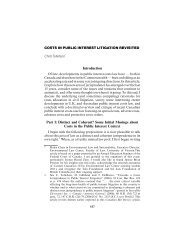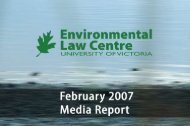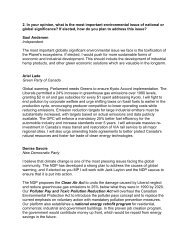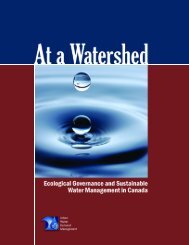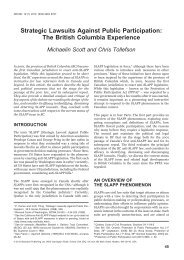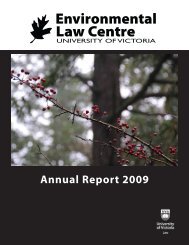Peeling back the Pavement - POLIS Water Sustainability Project
Peeling back the Pavement - POLIS Water Sustainability Project
Peeling back the Pavement - POLIS Water Sustainability Project
You also want an ePaper? Increase the reach of your titles
YUMPU automatically turns print PDFs into web optimized ePapers that Google loves.
13. Although <strong>the</strong> Fisheries Act does not address stormwater in <strong>the</strong> public realm (e.g. roads), it does factor into<br />
design on private property in S.35 & S.36.<br />
14. Saskatchewan Environment, Environmental Protection Branch. (2006, April). Stormwater Guidelines<br />
(EPB 322). Retrieved from www.saskh2o.ca/DWBinder/EPB322StormwaterGuidelines.pdf; Ontario<br />
Ministry of <strong>the</strong> Environment. (2003, March). Stormwater Management Planning and Design Manual.<br />
Ontario: Queen’s Printer for Ontario. Retrieved from www.ene.gov.on.ca/stdprodconsume/groups/lr/@<br />
ene/@resources/documents/resource/std01_079721.pdf; Inter-Governmental Partnership, & Green Infrastructure<br />
Partnership. (2007, June). Beyond <strong>the</strong> Guidebook: Context for Rainwater Management and<br />
Green Infrastructure in British Columbia. Retrieved from http://www.waterbucket.ca/rm/sites/wbcrm/<br />
documents/media/37.pdf<br />
15. Stephens, K. et al. (Forthcoming 2011). Rainwater Management in a <strong>Water</strong>shed Context – What’s <strong>the</strong><br />
Goal? Stormwater Magazine.<br />
16. Additional factors need to be considered before increasing development in certain areas. For example,<br />
areas that are densely developed are less likely to have proper stormwater management, which<br />
may contribute to flooding and erosion issues. Prescribing growth in <strong>the</strong>se areas can exacerbate <strong>the</strong><br />
negative impacts of impervious cover. When determining where to increase development, communities<br />
should take environmental capacity into consideration with respect to water supply, natural heritage,<br />
and resource protection, ra<strong>the</strong>r than a desktop planning exercise. For <strong>the</strong>se types of reasons, municipalities<br />
in Ontario are struggling with <strong>the</strong> Places to Grow legislation, and regions that are intended to<br />
meet growth targets are concerned with providing adequate water supply and wastewater services<br />
while protecting natural resources.<br />
17. See U.S. Environmental Protection Agency. (1996). Why <strong>Water</strong>sheds? Retrieved from http://www.<br />
epa.gov/owow/watershed/why.html<br />
18. See <strong>Water</strong> Centric Planning. (2011). Retrieved from http://www.waterbucket.ca/wcp/; see also<br />
Convening for Action. (2011). Retrieved from http://www.waterbucket.ca/cfa/; Partnership for <strong>Water</strong><br />
<strong>Sustainability</strong> in BC Web site. (n.d.). Retrieved from http://watersustainabilitybc.blogspot.com/<br />
19. Podolsky, L., & MacDonald, E. (2008, August). Green Cities, Great Lakes: Using Green Infrastructure<br />
to Reduce Combined Sewer Overflows. Ecojustice. Retrieved from http://www.ecojustice.ca/publications/reports/<strong>the</strong>-green-infrastructure-report/attachment<br />
20. See Brandes, O. M., Ferguson, K., M’Gonigle, M., & Sandborn, C. (2005, May). At a <strong>Water</strong>shed: Ecological<br />
Governance and Sustainable <strong>Water</strong> Management in Canada. Victoria, Canada: <strong>POLIS</strong> <strong>Project</strong> on<br />
Ecological Governance at <strong>the</strong> University of Victoria. Retrieved from http://www.poliswaterproject.org/<br />
publication/24; see also <strong>POLIS</strong> <strong>Project</strong> on Ecological Governance website, http://www.polisproject.org<br />
21. For a detailed discussion on this kind of governance reform see Brandes, O. M., & Curran, D. (2009,<br />
May). Setting a New Course in British Columbia–<strong>Water</strong> Governance Reform Options and Opportunities.<br />
Victoria, Canada: <strong>POLIS</strong> <strong>Project</strong> on Ecological Governance at <strong>the</strong> University of Victoria. Retrieved from<br />
http://www.poliswaterproject.org/publication/272<br />
22. A good example of this type of institutional foundation that is able to change and adapt to <strong>the</strong> challenges<br />
associated with this watershed perspective are Ontario’s Conservation Authorities, which were<br />
established shortly after <strong>the</strong> introduction of <strong>the</strong> Conservation Act in 1946. This model has received significant<br />
recognition and Conservation Authorities work with municipal partners to establish watershedbased<br />
goals for protecting, restoring, and managing resources.<br />
23. See for example Hood, M. J., Clausen, J.C., & Warner, G.S. (2007). Comparison of Stormwater Lag<br />
Times for Low Impact and Traditional Residential Development. Journal of <strong>the</strong> American <strong>Water</strong> Resources<br />
Association, 43(4), 1036–1046. doi:10.1111/j.1752-1688.2007.00085.x<br />
24. Stratus Consulting Inc. (2009, August 24). A Triple Bottom Line Assessment of Traditional and Green<br />
Infrastructure Options for Controlling CSO Events in Philadelphia’s <strong>Water</strong>sheds–Final Report. Retrieved<br />
from www.epa.gov/npdes/pubs/gi_phil_bottomline.pdf; Forest Research. (2010, October). Benefits of<br />
green infrastructure. Report to Defra and CLG. Forest Research, Farnham. Retrieved from http://www.<br />
forestresearch.gov.uk/pdf/urgp_benefits_of_green_infrastructure_main_report.pdf/$FILE/urgp_benefits_of_green_infrastructure_main_report.pdf<br />
62



